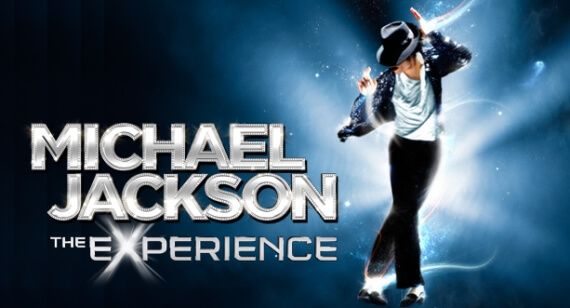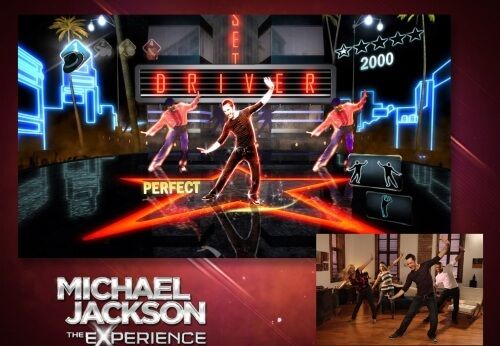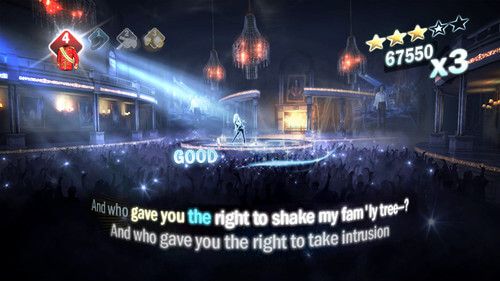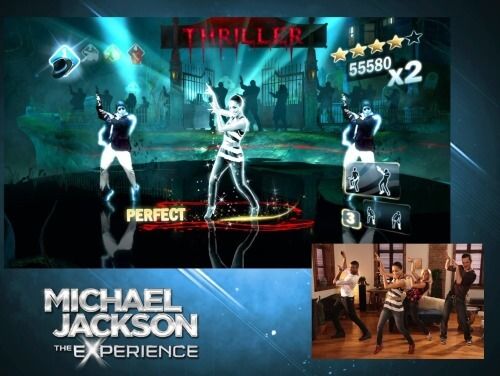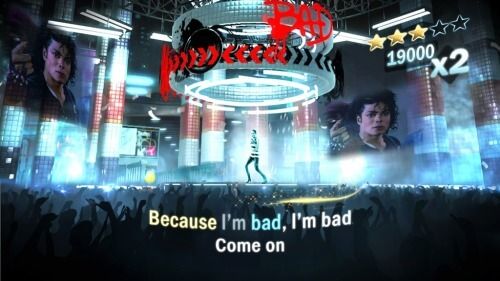When it comes to music and dancing, there simply is nobody like Michael Jackson. So with the recent peripheral technology made possible with the PlayStation Move and Microsoft Kinect bringing players' entire bodies into the experience, it was only a matter of time before a developer brought the legendary performer into the motion gaming age. Ubisoft is attempting to establish themselves as Kinect experts by doing just that with Michael Jackson: The Experience, but do they manage to pull of a game that matches the polished and one-of-a-kind performances of the King of Pop, or is the game little more than a fan service? The answer is a bit of both, and anything but simple.
Ubisoft has enjoyed massive success with its previous dance titles Just Dance and Just Dance 2, and millions of copies of Michael Jackson: The Experience sold on the DS, Wii, and PSP. But Kinect and Move owners have had to wait a bit longer for the one game that some might expect will make the costly peripherals worthwhile.
Kinect owners have already had months to grow accustomed to the incredibly polished and intuitive Dance Central from Harmonix, so Ubisoft already has some serious competition to face off against. Fans who expect MJ:TE to be nothing more than just Dance Central with Michael Jackson tracks may be disappointed to realize that different games play very differently, and often not how you would expect.
After my time with Michael Jackson: The Experience on the Xbox 360, two things are clear: Ubisoft has managed to run into many of the stumbling blocks that Harmonix miraculously avoided, and that nothing compares to dancing and singing along with the King of Pop.
It would be a mistake to interpret MJ:TE as yet another cookie-cutter dance title, since its intentions are clear, and more than simply offering some fun while working up a sweat. Any game brandishing Michael Jackson's name has to embody a commitment to dance, and the amount of content focused on choreography is proof. A fact made even clearer since the game is not incredibly deep or engrossing, at least not to professional dancers or die-hard MJ fans.
The game is divided into three parts: MJ School, Solo and Party modes. The Solo mode lets players dance to segments of classic MJ choreography in the 26 songs that come with the game. In Solo mode, each song gives the option to practice the required dance moves a section at a time in Practice Mode, try their hand at performing the moves on stage in Dance Mode, or combine both dancing and singing in Performance Mode.
In one of the more striking features of MJ:TE, the player's movements aren't reflected in an animated avatar onscreen, but real time video of the player that the developers call 'Player Projection.' The result is a ghost-like and shimmering version of your own face, proportions and clothing dancing in time with the game's at-time crudely-animated dancers.
This unfortunately means that clumsy dancers will have no avatars to hide behind, but the ability to wear MJ-esque hats and clothes is a major plus. The idea isn't implemented perfectly though, as the small amount pf input lag through the Kinect camera can generate some serious confusion when trying to time moves to the music and the projection on screen.
The singing is made possible through the Kinect's built-in microphone, but an external headset or microphone is also possible for those craving a bit more realism. While these might sound like a good variety, in practice they certainly leave the player wanting more. Want to get more extensive feedback on a particular move you're having trouble with? Dance Central gives players the ability to slow the music, and be talked through the move one beat at a time, highlighting the body part that is giving you trouble.
Continue to page 2 for the rest of our Michael Jackson: The Experience Review!
No such advice is found here, with the only option being to repeat the section over and over, and figure out how your own moves differ from those of the animated back-up dancers. From there, you can move onto performing a significantly simplified version of some of Jackson's most famous music videos, or combine dance sections with karaoke verses for those who love to sing as well as dance. The idea is a great one, but without a pitch bar or precise highlighting of the lyrics, this section could prove more of a frustration than a dream come true for those who have yet to memorize their favorite MJ songs.
While it would make sense to offer players a bit of range in difficulty, Ubisoft apparently felt that giving a beginner's take on MJ's dance steps would be sufficient before throwing them into the Master Performance Mode. This mode puts players on stage to perform dance numbers taken nearly move for move from Jackson's music videos, without any hand holding or difficulty curve.
The task wouldn't be that monumental if the systems and visual cues used during the dance were intuitive and straightforward, but sadly that isn't the case. MJ:TE implements the same flash-card system to show the dance moves that are coming up, but anyone who knows Michael Jackson knows that simplifying one of his dance moves into two still images is nearly impossible. The cards also have a hard time communcating how long to hold or repeat certain moves, often sending the players scrambling to find their footing or positioning for the next move in the sequence.
So in more demanding songs, players will likely find it more helpful to simply watch the back-up dancers for their visual cues, occasionally glancing at the cue cards to see what basic footing or body positioning will be needed prior to the various thrusting or gyrating that's called for. This strategy helps in keeping up with the song, but hopefully the description makes it clear that doing so is just as much work as fun. If you were hoping to cut loose and dance like Michael off the hop, it just isn't going to happen.
Friends and onlookers are definitely needed to keep the experience and frustrations worthwhile, since they will likely be a better reflection of how well the moves are being executed than anything the game offers. As opposed to the color schemes and auditory cues that signal a successful move in Dance Central, Michael Jackson: The Experience returns to the Dance Dance Revolution practice of merely displaying words like 'Good, Miss, Perfect' to emphasize accuracy. This isn't a problem in itself, but with so much to keep track of on screen, your individual score ends up being little more than an afterthought.
The Party Modes of the game allow you to alternate dancing and singing in Co-op, or go head to head in Battle Mode. The basic mechanics are the same as the solo experience, so having more friends taking part is what changes the mood and tempo. Games are always more fun with friends, and nothing is truer for Michael Jackson: The Experience. But if you do the majority of your dancing in a studio as opposed to parties, the game has something for you as well.
In the MJ School, three legitimate dance instructors are on-hand to walk you through the various dance moves and legendary sequences from the very beginnings of Michael Jackson's career. 'Walk through' is being used lightly here, since those without some dance experience will receive a reality check when they grasp just how difficult many of their favorite moves are to execute. The mode is a fantastic addition for more accomplished dancers, and one we hope to see integrated into future Kinect dance titles.
For the average or casual gamer - you know, the ones most likely to pick up both a Kinect and Michael Jackson: The Experience - the experience is a relatively shallow one. The star of the game is the 26 songs and dance numbers, and that is it. Almost all of MJ's biggest hits are represented, with 'Thriller,' 'Beat It,' 'Bad,' 'Smooth Criminal,' and 'Black or White' having most of the legend's most famous and well-known numbers covered. But even so, an extended play session is guaranteeing the fact that many songs will be repeated 3, 4, or even 5 times. The music is more than enjoyable enough, but that kind of repetition is a clear sign of a lack of successful content.
The inevitable question then becomes whether or not the music and dancing is enough to carry an entire game, and that is not easily answered. Dance Central and Rock Band demonstrated that Harmonix knew just how important mechanics are to an entertaining experience, not just the music being played. How many completely unknown songs or dance numbers became favorites due only the fact that they were incredibly fun to perform? To make a truly enjoyable and complete game, dancing to a song needs to be just as much fun as hearing it.
But while the game may not be anywhere near as polished, streamlined, or helpful as other titles have shown it could be, it is a good place to start with a technology as new as the Kinect. And when you get right down to it, there is a lot that players will be willing to put up with to dance to some of their favorite songs. I know I was.
So if you are a die-hard Michael Jackson fan with friends who would love a night of his best music and dancing, buying Michael Jackson: The Experience is a no-brainer, especially considering the sparse catalog of Kinect titles with high-production values. But if Dance Central was challenging enough to test your patience, then a rental would be the recommendation. You will know if the game's lack of hand-holding is more frustrating than fun in your first few minutes of playing, but the game is certainly worth a shot.
Ultimately, the music and dancing of Michael Jackson goes a long way to make up for the shortcomings and clumsy gameplay elements. For anyone but the most passionate fans, however, it will always be necessary to battle frustration to find the fun.
Michael Jackson: The Experience is available now for the Xbox 360 Kinect, and the PlayStation 3 with Move. The game was previously released for the Nintendo Wii, DS, and PSP.

